Organisational Behaviour Report: A David & Co. and its impact
VerifiedAdded on 2020/10/22
|14
|4713
|322
Report
AI Summary
This report examines organisational behaviour within the context of A David & Company Ltd., exploring the influence of culture, power, and politics on individual and team performance. It delves into motivational theories, including content and process theories, and their application in achieving organisational goals. The report also analyses different team structures, strategies for effective teamwork, and the impact of the path-goal theory on employee performance. Furthermore, it identifies and discusses the problems and barriers that can hinder effective performance within an organisation, providing a comprehensive overview of organisational behaviour principles and their practical implications. This report is designed to provide insights into how organisational structures and management practices influence employee behaviour and productivity.
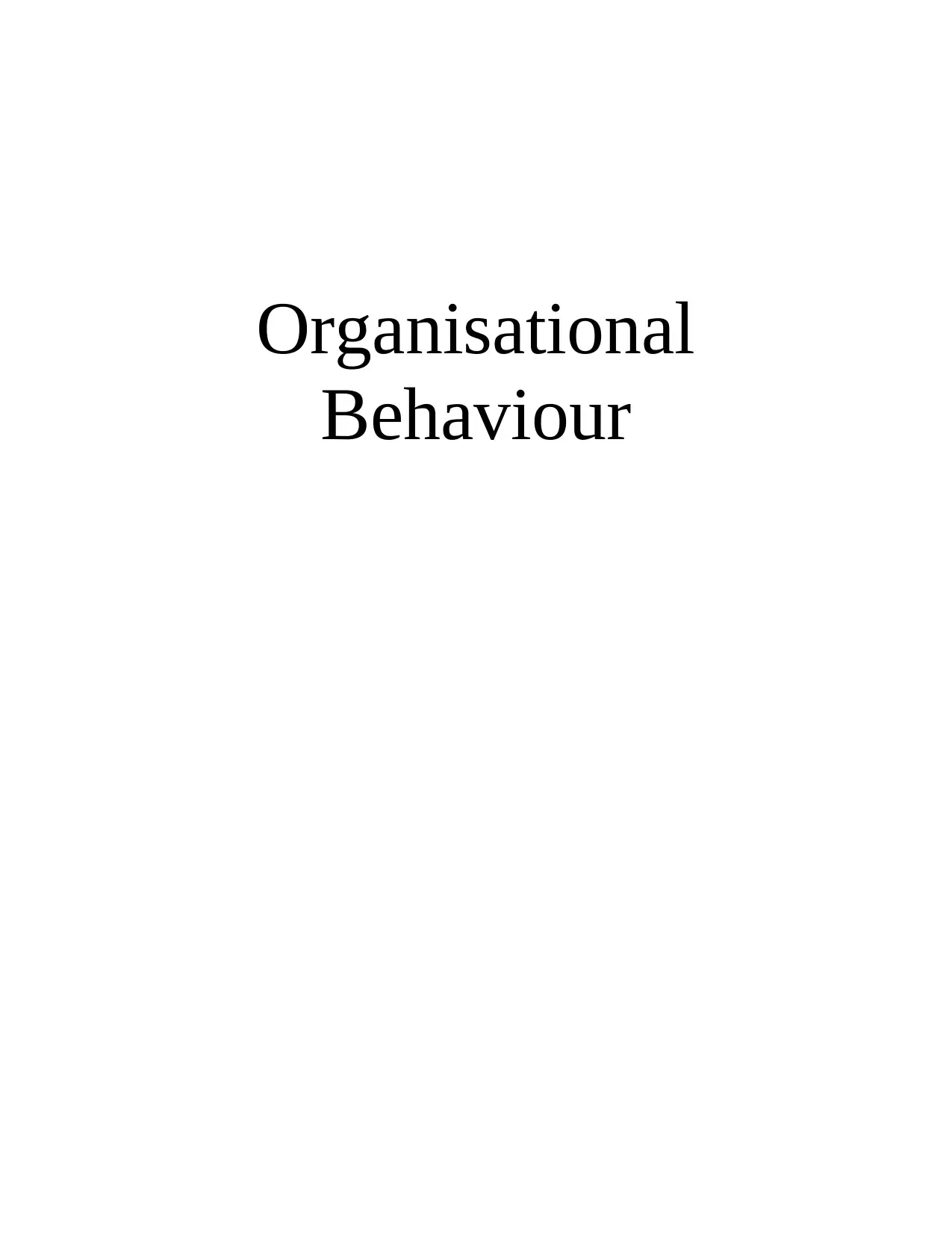
Organisational
Behaviour
Behaviour
Paraphrase This Document
Need a fresh take? Get an instant paraphrase of this document with our AI Paraphraser
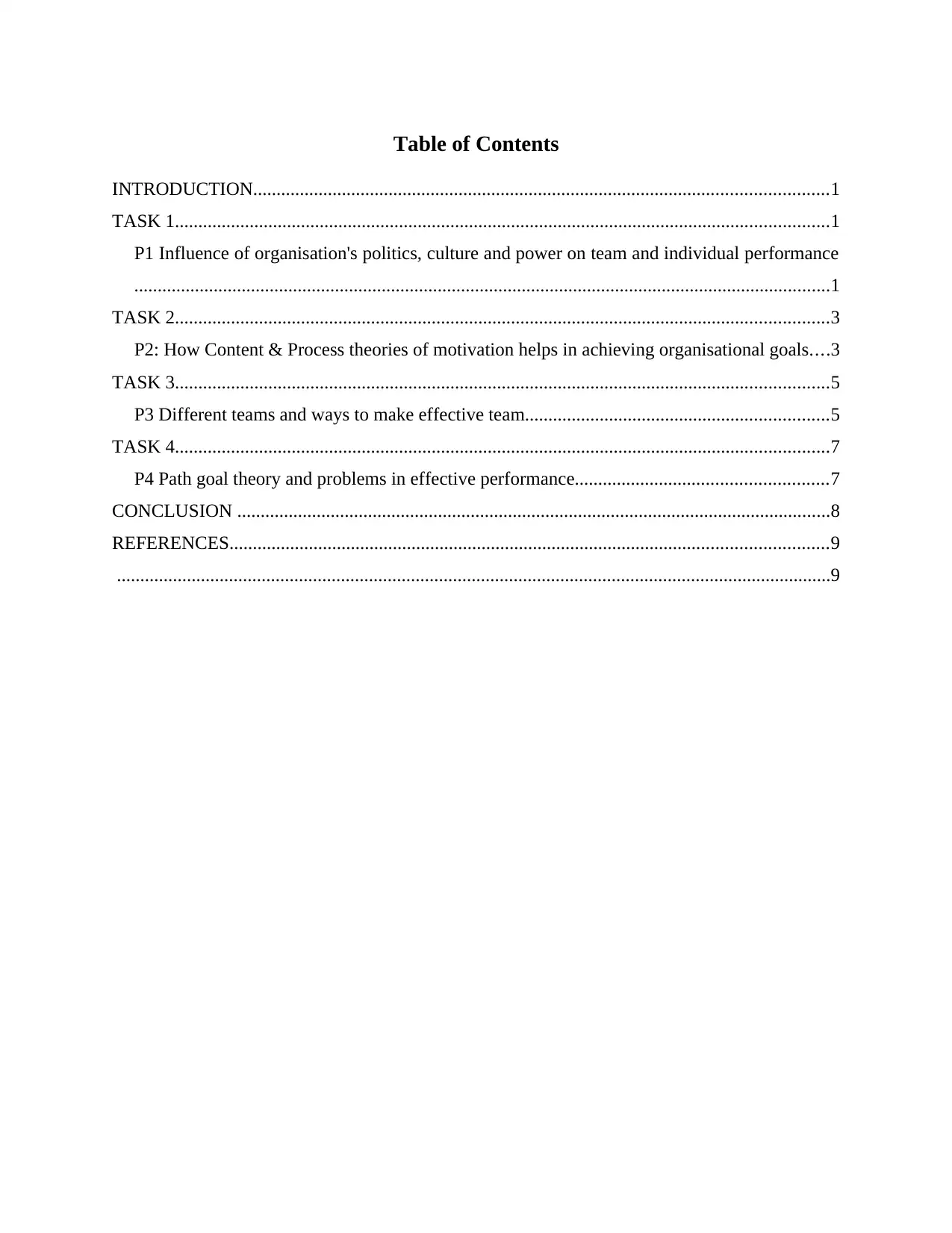
Table of Contents
INTRODUCTION...........................................................................................................................1
TASK 1............................................................................................................................................1
P1 Influence of organisation's politics, culture and power on team and individual performance
.....................................................................................................................................................1
TASK 2............................................................................................................................................3
P2: How Content & Process theories of motivation helps in achieving organisational goals....3
TASK 3............................................................................................................................................5
P3 Different teams and ways to make effective team.................................................................5
TASK 4............................................................................................................................................7
P4 Path goal theory and problems in effective performance......................................................7
CONCLUSION ...............................................................................................................................8
REFERENCES................................................................................................................................9
.........................................................................................................................................................9
INTRODUCTION...........................................................................................................................1
TASK 1............................................................................................................................................1
P1 Influence of organisation's politics, culture and power on team and individual performance
.....................................................................................................................................................1
TASK 2............................................................................................................................................3
P2: How Content & Process theories of motivation helps in achieving organisational goals....3
TASK 3............................................................................................................................................5
P3 Different teams and ways to make effective team.................................................................5
TASK 4............................................................................................................................................7
P4 Path goal theory and problems in effective performance......................................................7
CONCLUSION ...............................................................................................................................8
REFERENCES................................................................................................................................9
.........................................................................................................................................................9
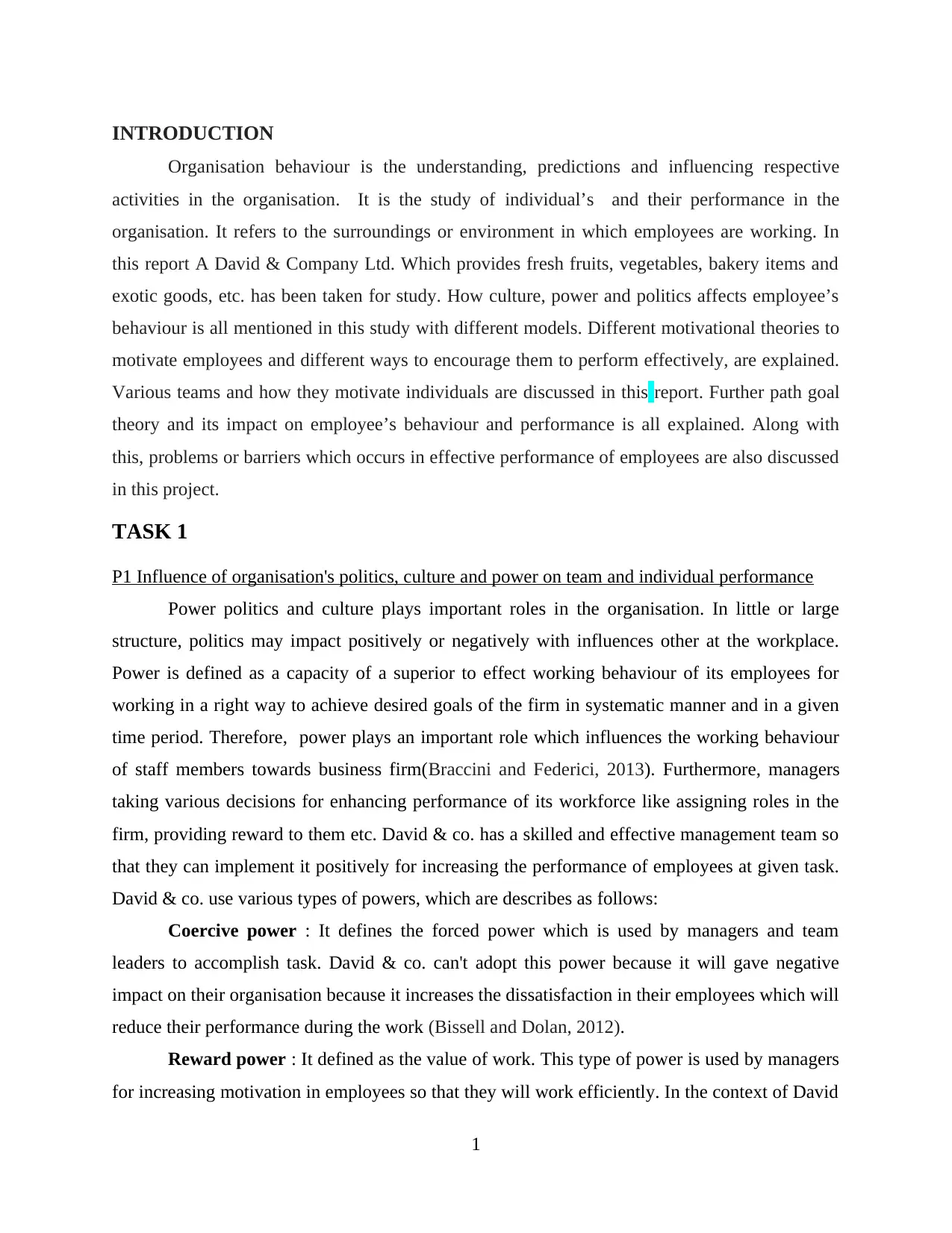
INTRODUCTION
Organisation behaviour is the understanding, predictions and influencing respective
activities in the organisation. It is the study of individual’s and their performance in the
organisation. It refers to the surroundings or environment in which employees are working. In
this report A David & Company Ltd. Which provides fresh fruits, vegetables, bakery items and
exotic goods, etc. has been taken for study. How culture, power and politics affects employee’s
behaviour is all mentioned in this study with different models. Different motivational theories to
motivate employees and different ways to encourage them to perform effectively, are explained.
Various teams and how they motivate individuals are discussed in this report. Further path goal
theory and its impact on employee’s behaviour and performance is all explained. Along with
this, problems or barriers which occurs in effective performance of employees are also discussed
in this project.
TASK 1
P1 Influence of organisation's politics, culture and power on team and individual performance
Power politics and culture plays important roles in the organisation. In little or large
structure, politics may impact positively or negatively with influences other at the workplace.
Power is defined as a capacity of a superior to effect working behaviour of its employees for
working in a right way to achieve desired goals of the firm in systematic manner and in a given
time period. Therefore, power plays an important role which influences the working behaviour
of staff members towards business firm(Braccini and Federici, 2013). Furthermore, managers
taking various decisions for enhancing performance of its workforce like assigning roles in the
firm, providing reward to them etc. David & co. has a skilled and effective management team so
that they can implement it positively for increasing the performance of employees at given task.
David & co. use various types of powers, which are describes as follows:
Coercive power : It defines the forced power which is used by managers and team
leaders to accomplish task. David & co. can't adopt this power because it will gave negative
impact on their organisation because it increases the dissatisfaction in their employees which will
reduce their performance during the work (Bissell and Dolan, 2012).
Reward power : It defined as the value of work. This type of power is used by managers
for increasing motivation in employees so that they will work efficiently. In the context of David
1
Organisation behaviour is the understanding, predictions and influencing respective
activities in the organisation. It is the study of individual’s and their performance in the
organisation. It refers to the surroundings or environment in which employees are working. In
this report A David & Company Ltd. Which provides fresh fruits, vegetables, bakery items and
exotic goods, etc. has been taken for study. How culture, power and politics affects employee’s
behaviour is all mentioned in this study with different models. Different motivational theories to
motivate employees and different ways to encourage them to perform effectively, are explained.
Various teams and how they motivate individuals are discussed in this report. Further path goal
theory and its impact on employee’s behaviour and performance is all explained. Along with
this, problems or barriers which occurs in effective performance of employees are also discussed
in this project.
TASK 1
P1 Influence of organisation's politics, culture and power on team and individual performance
Power politics and culture plays important roles in the organisation. In little or large
structure, politics may impact positively or negatively with influences other at the workplace.
Power is defined as a capacity of a superior to effect working behaviour of its employees for
working in a right way to achieve desired goals of the firm in systematic manner and in a given
time period. Therefore, power plays an important role which influences the working behaviour
of staff members towards business firm(Braccini and Federici, 2013). Furthermore, managers
taking various decisions for enhancing performance of its workforce like assigning roles in the
firm, providing reward to them etc. David & co. has a skilled and effective management team so
that they can implement it positively for increasing the performance of employees at given task.
David & co. use various types of powers, which are describes as follows:
Coercive power : It defines the forced power which is used by managers and team
leaders to accomplish task. David & co. can't adopt this power because it will gave negative
impact on their organisation because it increases the dissatisfaction in their employees which will
reduce their performance during the work (Bissell and Dolan, 2012).
Reward power : It defined as the value of work. This type of power is used by managers
for increasing motivation in employees so that they will work efficiently. In the context of David
1
⊘ This is a preview!⊘
Do you want full access?
Subscribe today to unlock all pages.

Trusted by 1+ million students worldwide
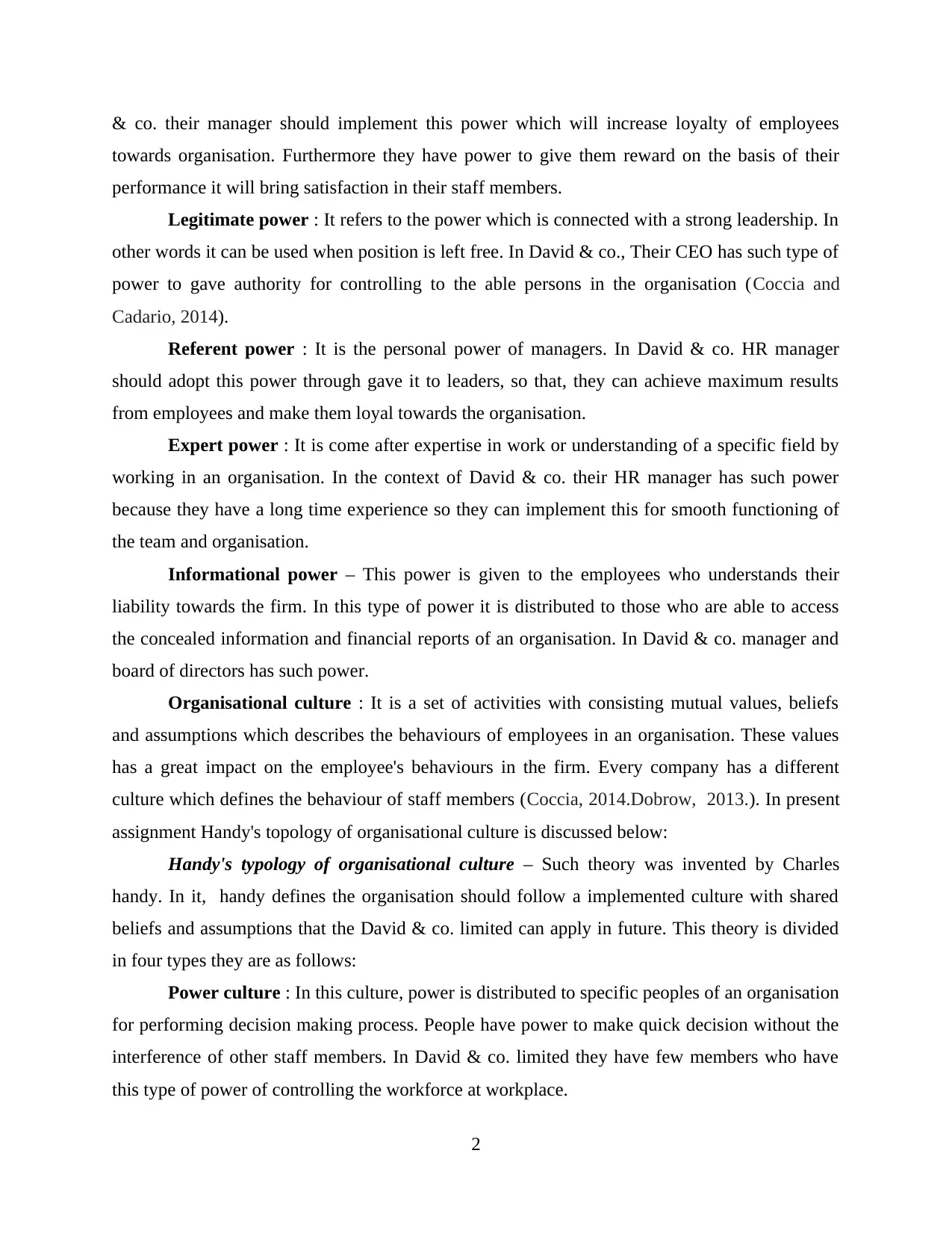
& co. their manager should implement this power which will increase loyalty of employees
towards organisation. Furthermore they have power to give them reward on the basis of their
performance it will bring satisfaction in their staff members.
Legitimate power : It refers to the power which is connected with a strong leadership. In
other words it can be used when position is left free. In David & co., Their CEO has such type of
power to gave authority for controlling to the able persons in the organisation (Coccia and
Cadario, 2014).
Referent power : It is the personal power of managers. In David & co. HR manager
should adopt this power through gave it to leaders, so that, they can achieve maximum results
from employees and make them loyal towards the organisation.
Expert power : It is come after expertise in work or understanding of a specific field by
working in an organisation. In the context of David & co. their HR manager has such power
because they have a long time experience so they can implement this for smooth functioning of
the team and organisation.
Informational power – This power is given to the employees who understands their
liability towards the firm. In this type of power it is distributed to those who are able to access
the concealed information and financial reports of an organisation. In David & co. manager and
board of directors has such power.
Organisational culture : It is a set of activities with consisting mutual values, beliefs
and assumptions which describes the behaviours of employees in an organisation. These values
has a great impact on the employee's behaviours in the firm. Every company has a different
culture which defines the behaviour of staff members (Coccia, 2014.Dobrow, 2013.). In present
assignment Handy's topology of organisational culture is discussed below:
Handy's typology of organisational culture – Such theory was invented by Charles
handy. In it, handy defines the organisation should follow a implemented culture with shared
beliefs and assumptions that the David & co. limited can apply in future. This theory is divided
in four types they are as follows:
Power culture : In this culture, power is distributed to specific peoples of an organisation
for performing decision making process. People have power to make quick decision without the
interference of other staff members. In David & co. limited they have few members who have
this type of power of controlling the workforce at workplace.
2
towards organisation. Furthermore they have power to give them reward on the basis of their
performance it will bring satisfaction in their staff members.
Legitimate power : It refers to the power which is connected with a strong leadership. In
other words it can be used when position is left free. In David & co., Their CEO has such type of
power to gave authority for controlling to the able persons in the organisation (Coccia and
Cadario, 2014).
Referent power : It is the personal power of managers. In David & co. HR manager
should adopt this power through gave it to leaders, so that, they can achieve maximum results
from employees and make them loyal towards the organisation.
Expert power : It is come after expertise in work or understanding of a specific field by
working in an organisation. In the context of David & co. their HR manager has such power
because they have a long time experience so they can implement this for smooth functioning of
the team and organisation.
Informational power – This power is given to the employees who understands their
liability towards the firm. In this type of power it is distributed to those who are able to access
the concealed information and financial reports of an organisation. In David & co. manager and
board of directors has such power.
Organisational culture : It is a set of activities with consisting mutual values, beliefs
and assumptions which describes the behaviours of employees in an organisation. These values
has a great impact on the employee's behaviours in the firm. Every company has a different
culture which defines the behaviour of staff members (Coccia, 2014.Dobrow, 2013.). In present
assignment Handy's topology of organisational culture is discussed below:
Handy's typology of organisational culture – Such theory was invented by Charles
handy. In it, handy defines the organisation should follow a implemented culture with shared
beliefs and assumptions that the David & co. limited can apply in future. This theory is divided
in four types they are as follows:
Power culture : In this culture, power is distributed to specific peoples of an organisation
for performing decision making process. People have power to make quick decision without the
interference of other staff members. In David & co. limited they have few members who have
this type of power of controlling the workforce at workplace.
2
Paraphrase This Document
Need a fresh take? Get an instant paraphrase of this document with our AI Paraphraser
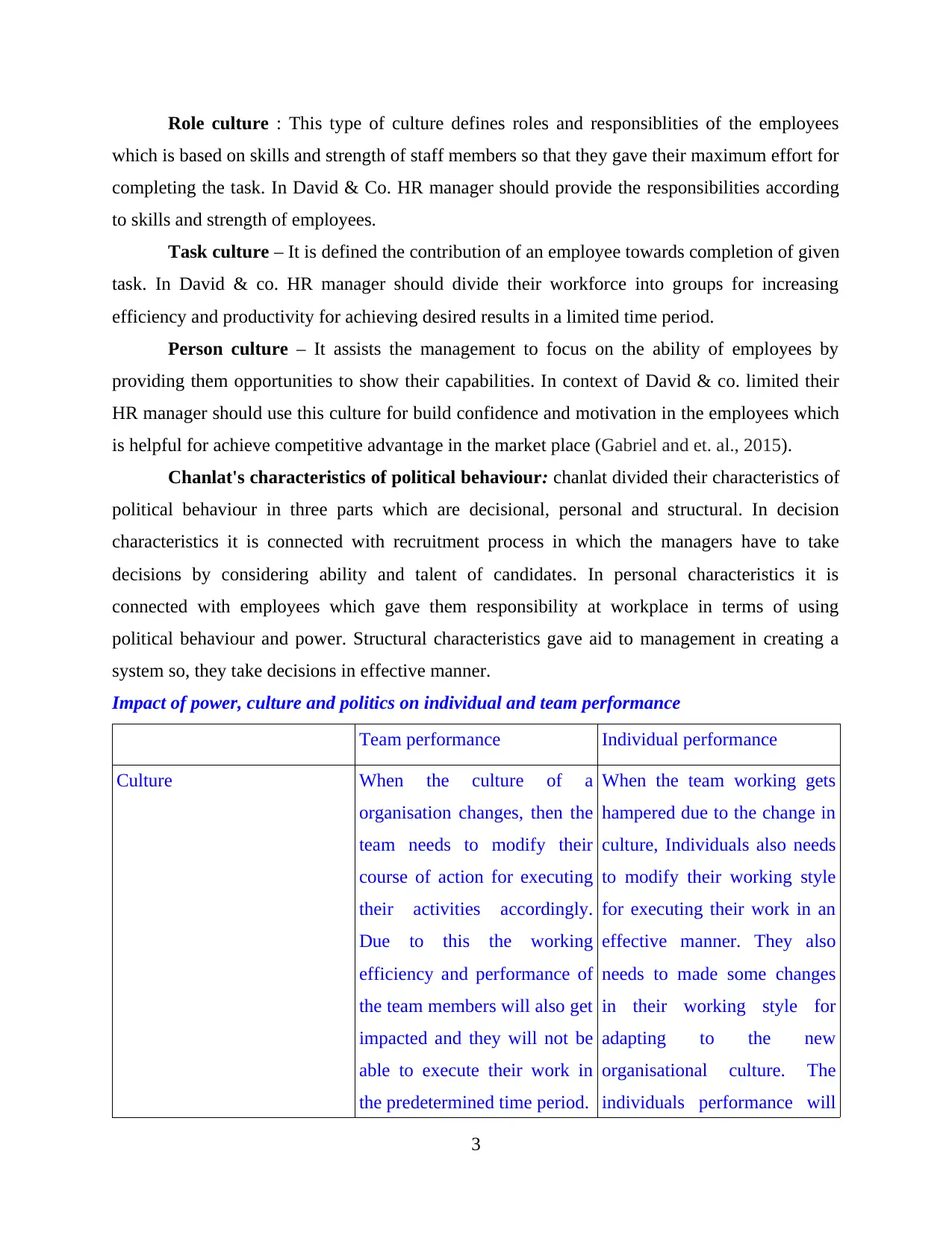
Role culture : This type of culture defines roles and responsiblities of the employees
which is based on skills and strength of staff members so that they gave their maximum effort for
completing the task. In David & Co. HR manager should provide the responsibilities according
to skills and strength of employees.
Task culture – It is defined the contribution of an employee towards completion of given
task. In David & co. HR manager should divide their workforce into groups for increasing
efficiency and productivity for achieving desired results in a limited time period.
Person culture – It assists the management to focus on the ability of employees by
providing them opportunities to show their capabilities. In context of David & co. limited their
HR manager should use this culture for build confidence and motivation in the employees which
is helpful for achieve competitive advantage in the market place (Gabriel and et. al., 2015).
Chanlat's characteristics of political behaviour: chanlat divided their characteristics of
political behaviour in three parts which are decisional, personal and structural. In decision
characteristics it is connected with recruitment process in which the managers have to take
decisions by considering ability and talent of candidates. In personal characteristics it is
connected with employees which gave them responsibility at workplace in terms of using
political behaviour and power. Structural characteristics gave aid to management in creating a
system so, they take decisions in effective manner.
Impact of power, culture and politics on individual and team performance
Team performance Individual performance
Culture When the culture of a
organisation changes, then the
team needs to modify their
course of action for executing
their activities accordingly.
Due to this the working
efficiency and performance of
the team members will also get
impacted and they will not be
able to execute their work in
the predetermined time period.
When the team working gets
hampered due to the change in
culture, Individuals also needs
to modify their working style
for executing their work in an
effective manner. They also
needs to made some changes
in their working style for
adapting to the new
organisational culture. The
individuals performance will
3
which is based on skills and strength of staff members so that they gave their maximum effort for
completing the task. In David & Co. HR manager should provide the responsibilities according
to skills and strength of employees.
Task culture – It is defined the contribution of an employee towards completion of given
task. In David & co. HR manager should divide their workforce into groups for increasing
efficiency and productivity for achieving desired results in a limited time period.
Person culture – It assists the management to focus on the ability of employees by
providing them opportunities to show their capabilities. In context of David & co. limited their
HR manager should use this culture for build confidence and motivation in the employees which
is helpful for achieve competitive advantage in the market place (Gabriel and et. al., 2015).
Chanlat's characteristics of political behaviour: chanlat divided their characteristics of
political behaviour in three parts which are decisional, personal and structural. In decision
characteristics it is connected with recruitment process in which the managers have to take
decisions by considering ability and talent of candidates. In personal characteristics it is
connected with employees which gave them responsibility at workplace in terms of using
political behaviour and power. Structural characteristics gave aid to management in creating a
system so, they take decisions in effective manner.
Impact of power, culture and politics on individual and team performance
Team performance Individual performance
Culture When the culture of a
organisation changes, then the
team needs to modify their
course of action for executing
their activities accordingly.
Due to this the working
efficiency and performance of
the team members will also get
impacted and they will not be
able to execute their work in
the predetermined time period.
When the team working gets
hampered due to the change in
culture, Individuals also needs
to modify their working style
for executing their work in an
effective manner. They also
needs to made some changes
in their working style for
adapting to the new
organisational culture. The
individuals performance will
3
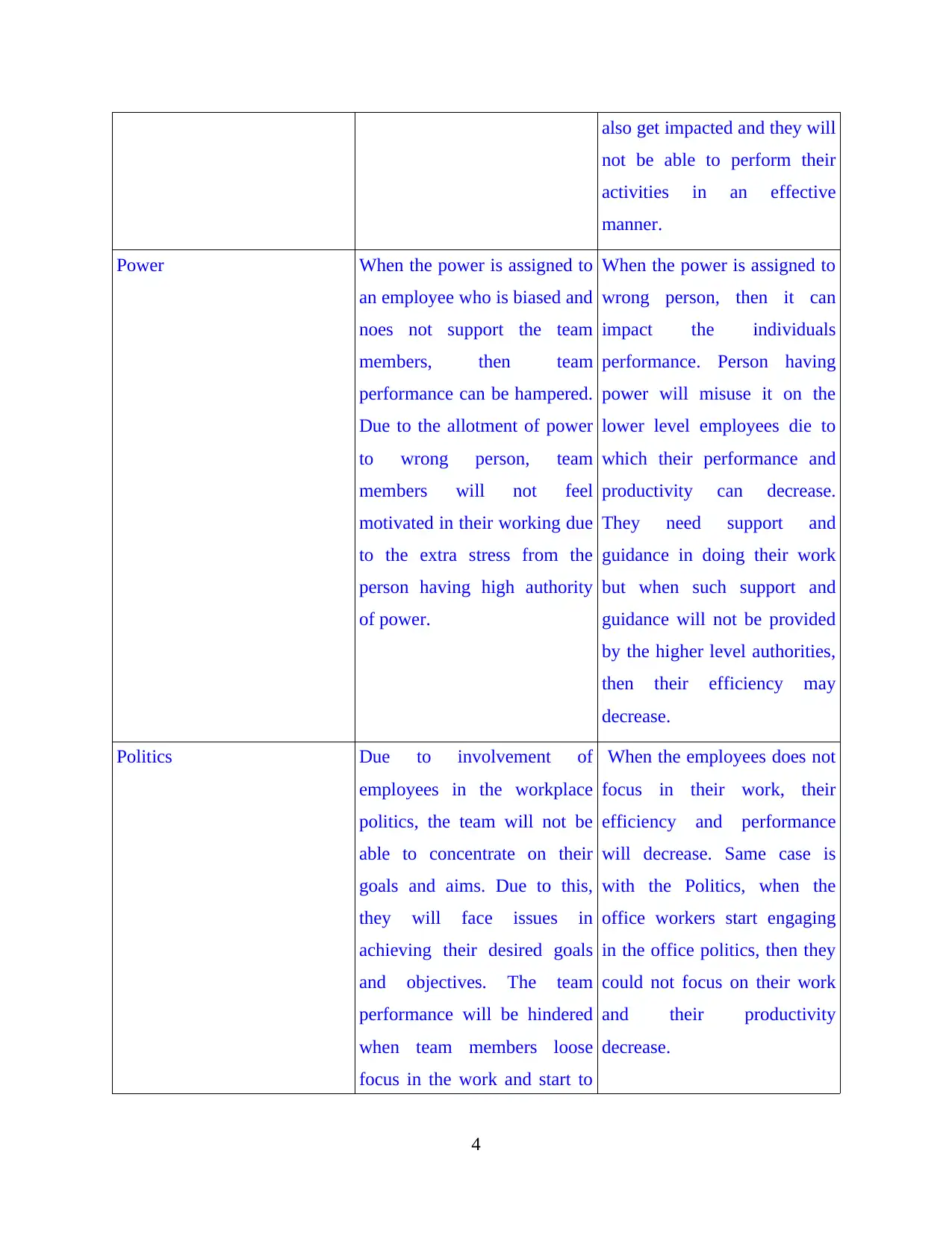
also get impacted and they will
not be able to perform their
activities in an effective
manner.
Power When the power is assigned to
an employee who is biased and
noes not support the team
members, then team
performance can be hampered.
Due to the allotment of power
to wrong person, team
members will not feel
motivated in their working due
to the extra stress from the
person having high authority
of power.
When the power is assigned to
wrong person, then it can
impact the individuals
performance. Person having
power will misuse it on the
lower level employees die to
which their performance and
productivity can decrease.
They need support and
guidance in doing their work
but when such support and
guidance will not be provided
by the higher level authorities,
then their efficiency may
decrease.
Politics Due to involvement of
employees in the workplace
politics, the team will not be
able to concentrate on their
goals and aims. Due to this,
they will face issues in
achieving their desired goals
and objectives. The team
performance will be hindered
when team members loose
focus in the work and start to
When the employees does not
focus in their work, their
efficiency and performance
will decrease. Same case is
with the Politics, when the
office workers start engaging
in the office politics, then they
could not focus on their work
and their productivity
decrease.
4
not be able to perform their
activities in an effective
manner.
Power When the power is assigned to
an employee who is biased and
noes not support the team
members, then team
performance can be hampered.
Due to the allotment of power
to wrong person, team
members will not feel
motivated in their working due
to the extra stress from the
person having high authority
of power.
When the power is assigned to
wrong person, then it can
impact the individuals
performance. Person having
power will misuse it on the
lower level employees die to
which their performance and
productivity can decrease.
They need support and
guidance in doing their work
but when such support and
guidance will not be provided
by the higher level authorities,
then their efficiency may
decrease.
Politics Due to involvement of
employees in the workplace
politics, the team will not be
able to concentrate on their
goals and aims. Due to this,
they will face issues in
achieving their desired goals
and objectives. The team
performance will be hindered
when team members loose
focus in the work and start to
When the employees does not
focus in their work, their
efficiency and performance
will decrease. Same case is
with the Politics, when the
office workers start engaging
in the office politics, then they
could not focus on their work
and their productivity
decrease.
4
⊘ This is a preview!⊘
Do you want full access?
Subscribe today to unlock all pages.

Trusted by 1+ million students worldwide
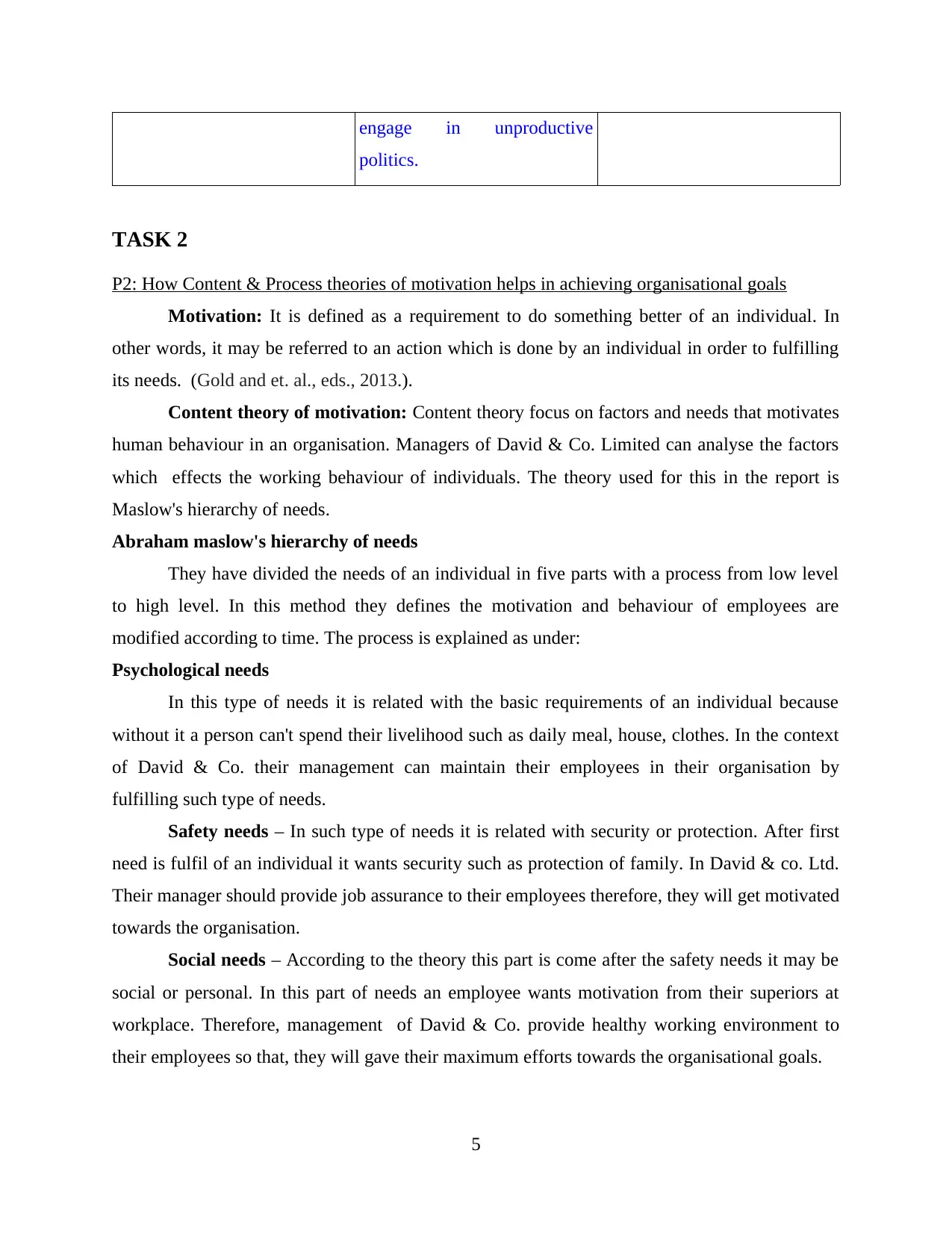
engage in unproductive
politics.
TASK 2
P2: How Content & Process theories of motivation helps in achieving organisational goals
Motivation: It is defined as a requirement to do something better of an individual. In
other words, it may be referred to an action which is done by an individual in order to fulfilling
its needs. (Gold and et. al., eds., 2013.).
Content theory of motivation: Content theory focus on factors and needs that motivates
human behaviour in an organisation. Managers of David & Co. Limited can analyse the factors
which effects the working behaviour of individuals. The theory used for this in the report is
Maslow's hierarchy of needs.
Abraham maslow's hierarchy of needs
They have divided the needs of an individual in five parts with a process from low level
to high level. In this method they defines the motivation and behaviour of employees are
modified according to time. The process is explained as under:
Psychological needs
In this type of needs it is related with the basic requirements of an individual because
without it a person can't spend their livelihood such as daily meal, house, clothes. In the context
of David & Co. their management can maintain their employees in their organisation by
fulfilling such type of needs.
Safety needs – In such type of needs it is related with security or protection. After first
need is fulfil of an individual it wants security such as protection of family. In David & co. Ltd.
Their manager should provide job assurance to their employees therefore, they will get motivated
towards the organisation.
Social needs – According to the theory this part is come after the safety needs it may be
social or personal. In this part of needs an employee wants motivation from their superiors at
workplace. Therefore, management of David & Co. provide healthy working environment to
their employees so that, they will gave their maximum efforts towards the organisational goals.
5
politics.
TASK 2
P2: How Content & Process theories of motivation helps in achieving organisational goals
Motivation: It is defined as a requirement to do something better of an individual. In
other words, it may be referred to an action which is done by an individual in order to fulfilling
its needs. (Gold and et. al., eds., 2013.).
Content theory of motivation: Content theory focus on factors and needs that motivates
human behaviour in an organisation. Managers of David & Co. Limited can analyse the factors
which effects the working behaviour of individuals. The theory used for this in the report is
Maslow's hierarchy of needs.
Abraham maslow's hierarchy of needs
They have divided the needs of an individual in five parts with a process from low level
to high level. In this method they defines the motivation and behaviour of employees are
modified according to time. The process is explained as under:
Psychological needs
In this type of needs it is related with the basic requirements of an individual because
without it a person can't spend their livelihood such as daily meal, house, clothes. In the context
of David & Co. their management can maintain their employees in their organisation by
fulfilling such type of needs.
Safety needs – In such type of needs it is related with security or protection. After first
need is fulfil of an individual it wants security such as protection of family. In David & co. Ltd.
Their manager should provide job assurance to their employees therefore, they will get motivated
towards the organisation.
Social needs – According to the theory this part is come after the safety needs it may be
social or personal. In this part of needs an employee wants motivation from their superiors at
workplace. Therefore, management of David & Co. provide healthy working environment to
their employees so that, they will gave their maximum efforts towards the organisational goals.
5
Paraphrase This Document
Need a fresh take? Get an instant paraphrase of this document with our AI Paraphraser
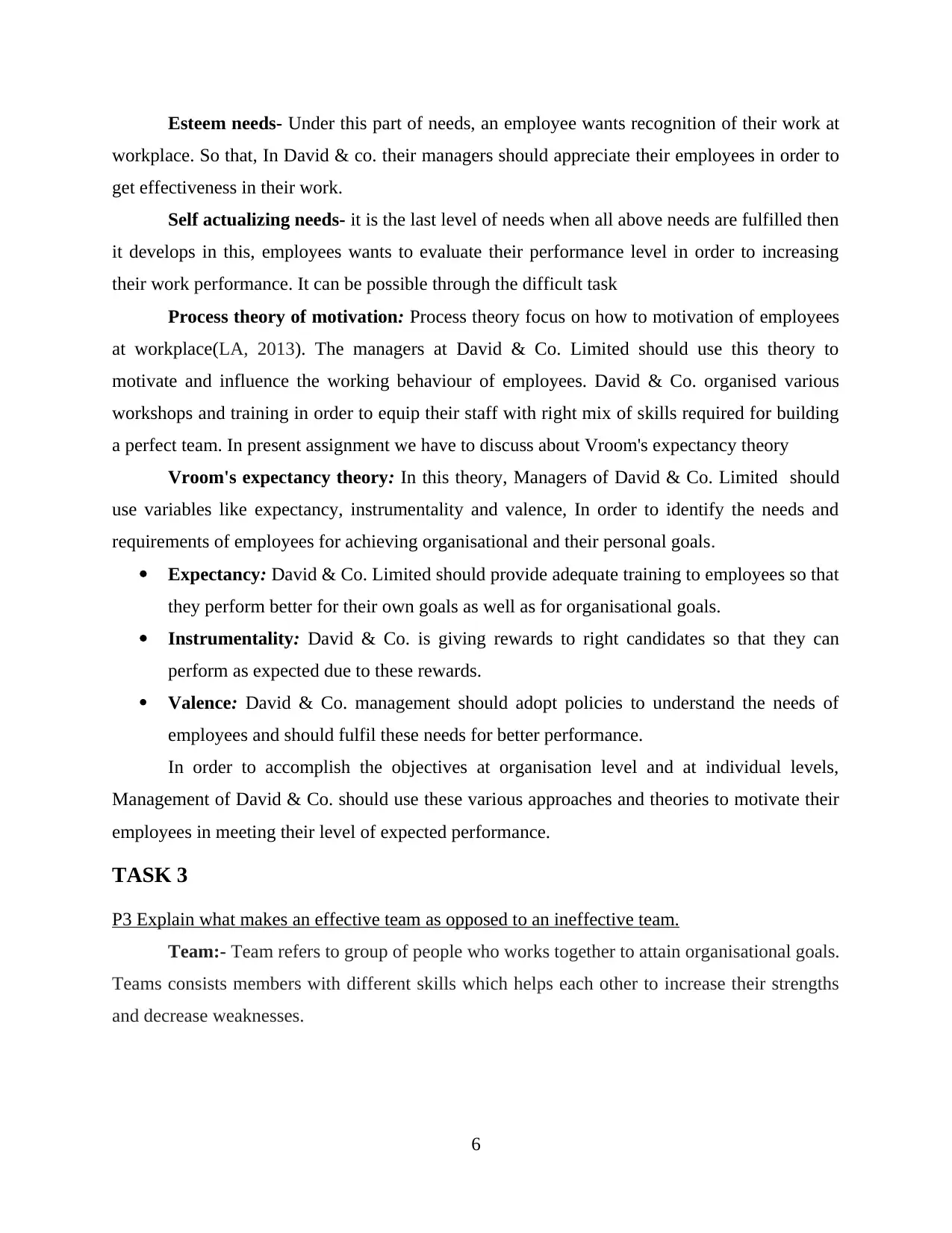
Esteem needs- Under this part of needs, an employee wants recognition of their work at
workplace. So that, In David & co. their managers should appreciate their employees in order to
get effectiveness in their work.
Self actualizing needs- it is the last level of needs when all above needs are fulfilled then
it develops in this, employees wants to evaluate their performance level in order to increasing
their work performance. It can be possible through the difficult task
Process theory of motivation: Process theory focus on how to motivation of employees
at workplace(LA, 2013). The managers at David & Co. Limited should use this theory to
motivate and influence the working behaviour of employees. David & Co. organised various
workshops and training in order to equip their staff with right mix of skills required for building
a perfect team. In present assignment we have to discuss about Vroom's expectancy theory
Vroom's expectancy theory: In this theory, Managers of David & Co. Limited should
use variables like expectancy, instrumentality and valence, In order to identify the needs and
requirements of employees for achieving organisational and their personal goals.
Expectancy: David & Co. Limited should provide adequate training to employees so that
they perform better for their own goals as well as for organisational goals.
Instrumentality: David & Co. is giving rewards to right candidates so that they can
perform as expected due to these rewards.
Valence: David & Co. management should adopt policies to understand the needs of
employees and should fulfil these needs for better performance.
In order to accomplish the objectives at organisation level and at individual levels,
Management of David & Co. should use these various approaches and theories to motivate their
employees in meeting their level of expected performance.
TASK 3
P3 Explain what makes an effective team as opposed to an ineffective team.
Team:- Team refers to group of people who works together to attain organisational goals.
Teams consists members with different skills which helps each other to increase their strengths
and decrease weaknesses.
6
workplace. So that, In David & co. their managers should appreciate their employees in order to
get effectiveness in their work.
Self actualizing needs- it is the last level of needs when all above needs are fulfilled then
it develops in this, employees wants to evaluate their performance level in order to increasing
their work performance. It can be possible through the difficult task
Process theory of motivation: Process theory focus on how to motivation of employees
at workplace(LA, 2013). The managers at David & Co. Limited should use this theory to
motivate and influence the working behaviour of employees. David & Co. organised various
workshops and training in order to equip their staff with right mix of skills required for building
a perfect team. In present assignment we have to discuss about Vroom's expectancy theory
Vroom's expectancy theory: In this theory, Managers of David & Co. Limited should
use variables like expectancy, instrumentality and valence, In order to identify the needs and
requirements of employees for achieving organisational and their personal goals.
Expectancy: David & Co. Limited should provide adequate training to employees so that
they perform better for their own goals as well as for organisational goals.
Instrumentality: David & Co. is giving rewards to right candidates so that they can
perform as expected due to these rewards.
Valence: David & Co. management should adopt policies to understand the needs of
employees and should fulfil these needs for better performance.
In order to accomplish the objectives at organisation level and at individual levels,
Management of David & Co. should use these various approaches and theories to motivate their
employees in meeting their level of expected performance.
TASK 3
P3 Explain what makes an effective team as opposed to an ineffective team.
Team:- Team refers to group of people who works together to attain organisational goals.
Teams consists members with different skills which helps each other to increase their strengths
and decrease weaknesses.
6
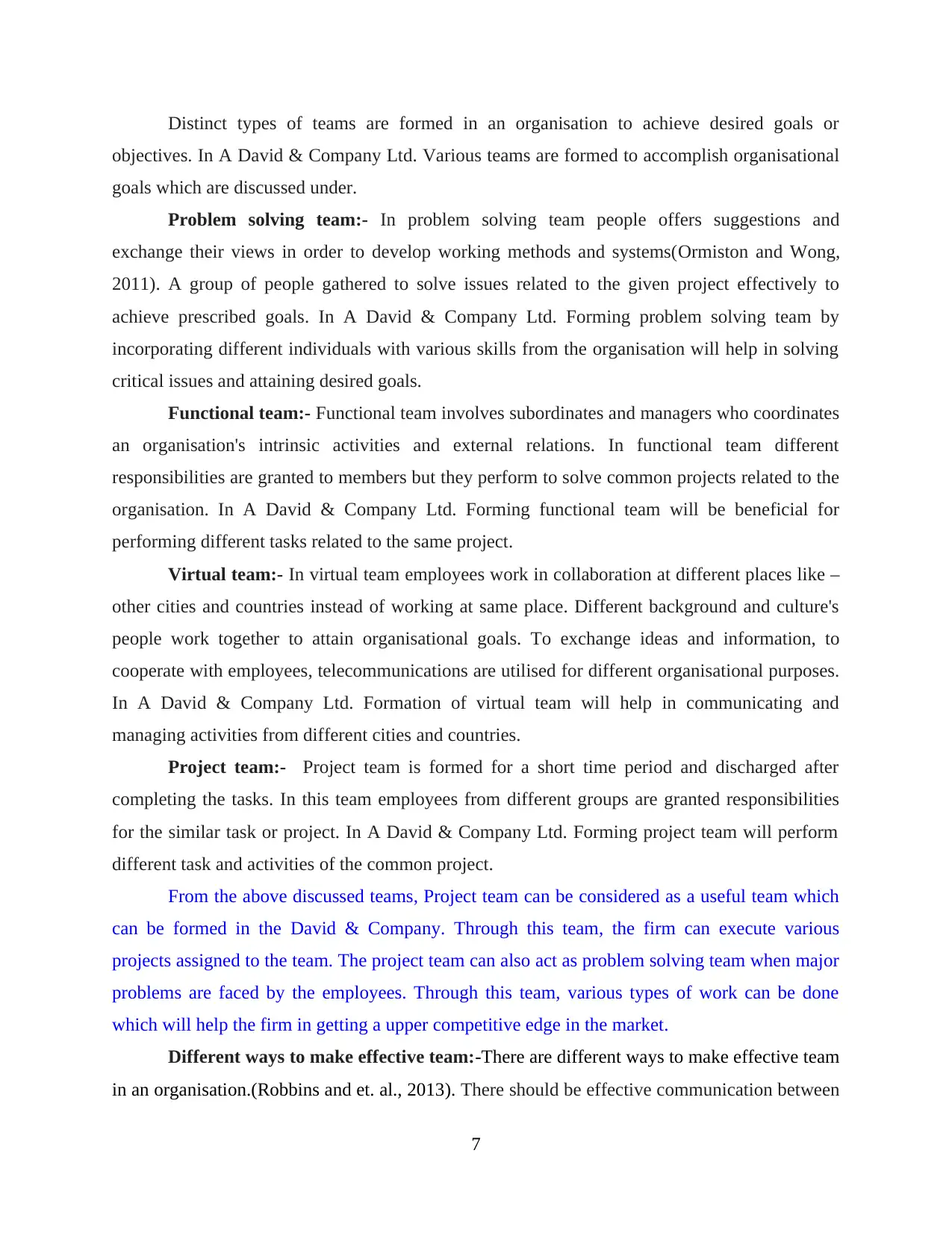
Distinct types of teams are formed in an organisation to achieve desired goals or
objectives. In A David & Company Ltd. Various teams are formed to accomplish organisational
goals which are discussed under.
Problem solving team:- In problem solving team people offers suggestions and
exchange their views in order to develop working methods and systems(Ormiston and Wong,
2011). A group of people gathered to solve issues related to the given project effectively to
achieve prescribed goals. In A David & Company Ltd. Forming problem solving team by
incorporating different individuals with various skills from the organisation will help in solving
critical issues and attaining desired goals.
Functional team:- Functional team involves subordinates and managers who coordinates
an organisation's intrinsic activities and external relations. In functional team different
responsibilities are granted to members but they perform to solve common projects related to the
organisation. In A David & Company Ltd. Forming functional team will be beneficial for
performing different tasks related to the same project.
Virtual team:- In virtual team employees work in collaboration at different places like –
other cities and countries instead of working at same place. Different background and culture's
people work together to attain organisational goals. To exchange ideas and information, to
cooperate with employees, telecommunications are utilised for different organisational purposes.
In A David & Company Ltd. Formation of virtual team will help in communicating and
managing activities from different cities and countries.
Project team:- Project team is formed for a short time period and discharged after
completing the tasks. In this team employees from different groups are granted responsibilities
for the similar task or project. In A David & Company Ltd. Forming project team will perform
different task and activities of the common project.
From the above discussed teams, Project team can be considered as a useful team which
can be formed in the David & Company. Through this team, the firm can execute various
projects assigned to the team. The project team can also act as problem solving team when major
problems are faced by the employees. Through this team, various types of work can be done
which will help the firm in getting a upper competitive edge in the market.
Different ways to make effective team:-There are different ways to make effective team
in an organisation.(Robbins and et. al., 2013). There should be effective communication between
7
objectives. In A David & Company Ltd. Various teams are formed to accomplish organisational
goals which are discussed under.
Problem solving team:- In problem solving team people offers suggestions and
exchange their views in order to develop working methods and systems(Ormiston and Wong,
2011). A group of people gathered to solve issues related to the given project effectively to
achieve prescribed goals. In A David & Company Ltd. Forming problem solving team by
incorporating different individuals with various skills from the organisation will help in solving
critical issues and attaining desired goals.
Functional team:- Functional team involves subordinates and managers who coordinates
an organisation's intrinsic activities and external relations. In functional team different
responsibilities are granted to members but they perform to solve common projects related to the
organisation. In A David & Company Ltd. Forming functional team will be beneficial for
performing different tasks related to the same project.
Virtual team:- In virtual team employees work in collaboration at different places like –
other cities and countries instead of working at same place. Different background and culture's
people work together to attain organisational goals. To exchange ideas and information, to
cooperate with employees, telecommunications are utilised for different organisational purposes.
In A David & Company Ltd. Formation of virtual team will help in communicating and
managing activities from different cities and countries.
Project team:- Project team is formed for a short time period and discharged after
completing the tasks. In this team employees from different groups are granted responsibilities
for the similar task or project. In A David & Company Ltd. Forming project team will perform
different task and activities of the common project.
From the above discussed teams, Project team can be considered as a useful team which
can be formed in the David & Company. Through this team, the firm can execute various
projects assigned to the team. The project team can also act as problem solving team when major
problems are faced by the employees. Through this team, various types of work can be done
which will help the firm in getting a upper competitive edge in the market.
Different ways to make effective team:-There are different ways to make effective team
in an organisation.(Robbins and et. al., 2013). There should be effective communication between
7
⊘ This is a preview!⊘
Do you want full access?
Subscribe today to unlock all pages.

Trusted by 1+ million students worldwide
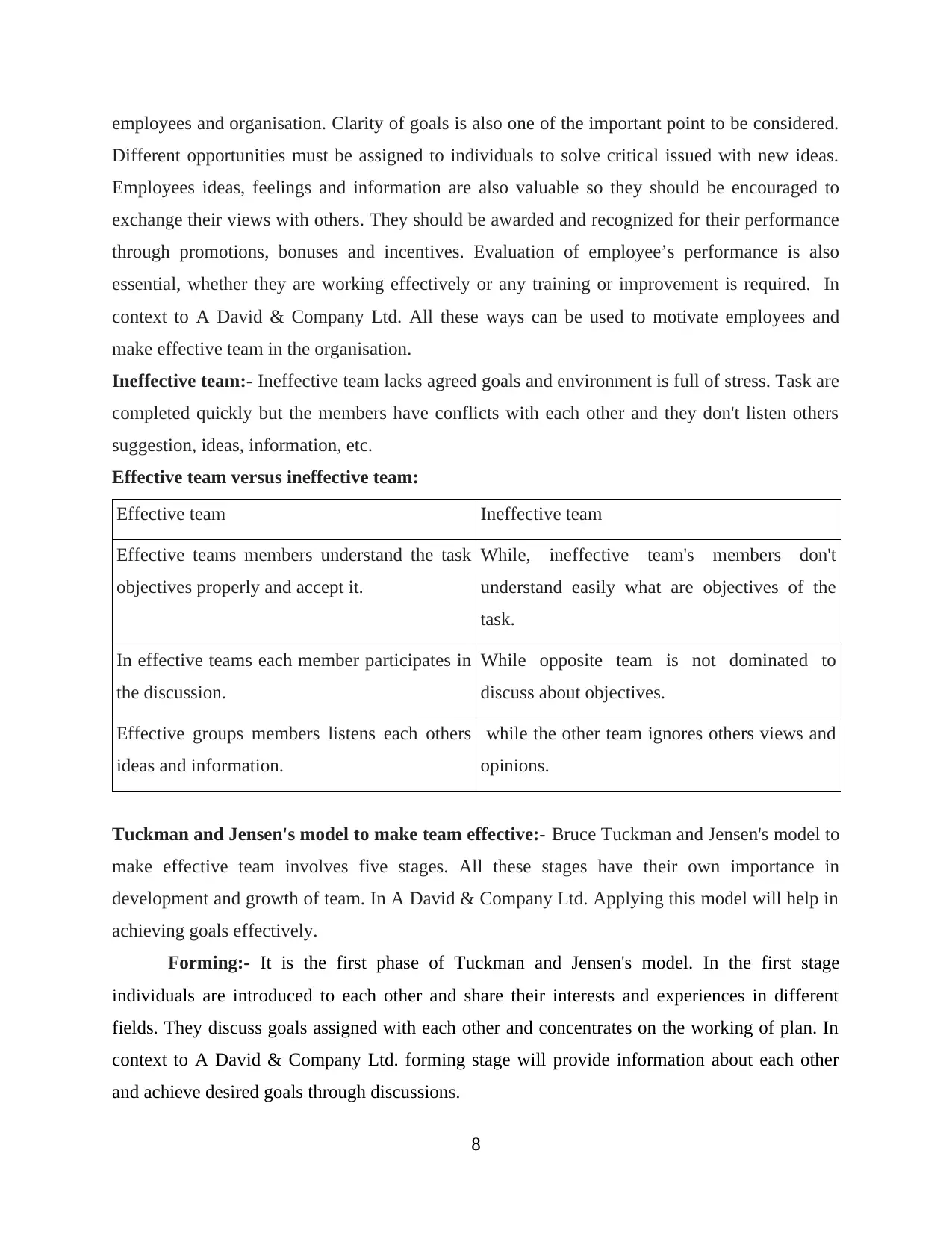
employees and organisation. Clarity of goals is also one of the important point to be considered.
Different opportunities must be assigned to individuals to solve critical issued with new ideas.
Employees ideas, feelings and information are also valuable so they should be encouraged to
exchange their views with others. They should be awarded and recognized for their performance
through promotions, bonuses and incentives. Evaluation of employee’s performance is also
essential, whether they are working effectively or any training or improvement is required. In
context to A David & Company Ltd. All these ways can be used to motivate employees and
make effective team in the organisation.
Ineffective team:- Ineffective team lacks agreed goals and environment is full of stress. Task are
completed quickly but the members have conflicts with each other and they don't listen others
suggestion, ideas, information, etc.
Effective team versus ineffective team:
Effective team Ineffective team
Effective teams members understand the task
objectives properly and accept it.
While, ineffective team's members don't
understand easily what are objectives of the
task.
In effective teams each member participates in
the discussion.
While opposite team is not dominated to
discuss about objectives.
Effective groups members listens each others
ideas and information.
while the other team ignores others views and
opinions.
Tuckman and Jensen's model to make team effective:- Bruce Tuckman and Jensen's model to
make effective team involves five stages. All these stages have their own importance in
development and growth of team. In A David & Company Ltd. Applying this model will help in
achieving goals effectively.
Forming:- It is the first phase of Tuckman and Jensen's model. In the first stage
individuals are introduced to each other and share their interests and experiences in different
fields. They discuss goals assigned with each other and concentrates on the working of plan. In
context to A David & Company Ltd. forming stage will provide information about each other
and achieve desired goals through discussions.
8
Different opportunities must be assigned to individuals to solve critical issued with new ideas.
Employees ideas, feelings and information are also valuable so they should be encouraged to
exchange their views with others. They should be awarded and recognized for their performance
through promotions, bonuses and incentives. Evaluation of employee’s performance is also
essential, whether they are working effectively or any training or improvement is required. In
context to A David & Company Ltd. All these ways can be used to motivate employees and
make effective team in the organisation.
Ineffective team:- Ineffective team lacks agreed goals and environment is full of stress. Task are
completed quickly but the members have conflicts with each other and they don't listen others
suggestion, ideas, information, etc.
Effective team versus ineffective team:
Effective team Ineffective team
Effective teams members understand the task
objectives properly and accept it.
While, ineffective team's members don't
understand easily what are objectives of the
task.
In effective teams each member participates in
the discussion.
While opposite team is not dominated to
discuss about objectives.
Effective groups members listens each others
ideas and information.
while the other team ignores others views and
opinions.
Tuckman and Jensen's model to make team effective:- Bruce Tuckman and Jensen's model to
make effective team involves five stages. All these stages have their own importance in
development and growth of team. In A David & Company Ltd. Applying this model will help in
achieving goals effectively.
Forming:- It is the first phase of Tuckman and Jensen's model. In the first stage
individuals are introduced to each other and share their interests and experiences in different
fields. They discuss goals assigned with each other and concentrates on the working of plan. In
context to A David & Company Ltd. forming stage will provide information about each other
and achieve desired goals through discussions.
8
Paraphrase This Document
Need a fresh take? Get an instant paraphrase of this document with our AI Paraphraser
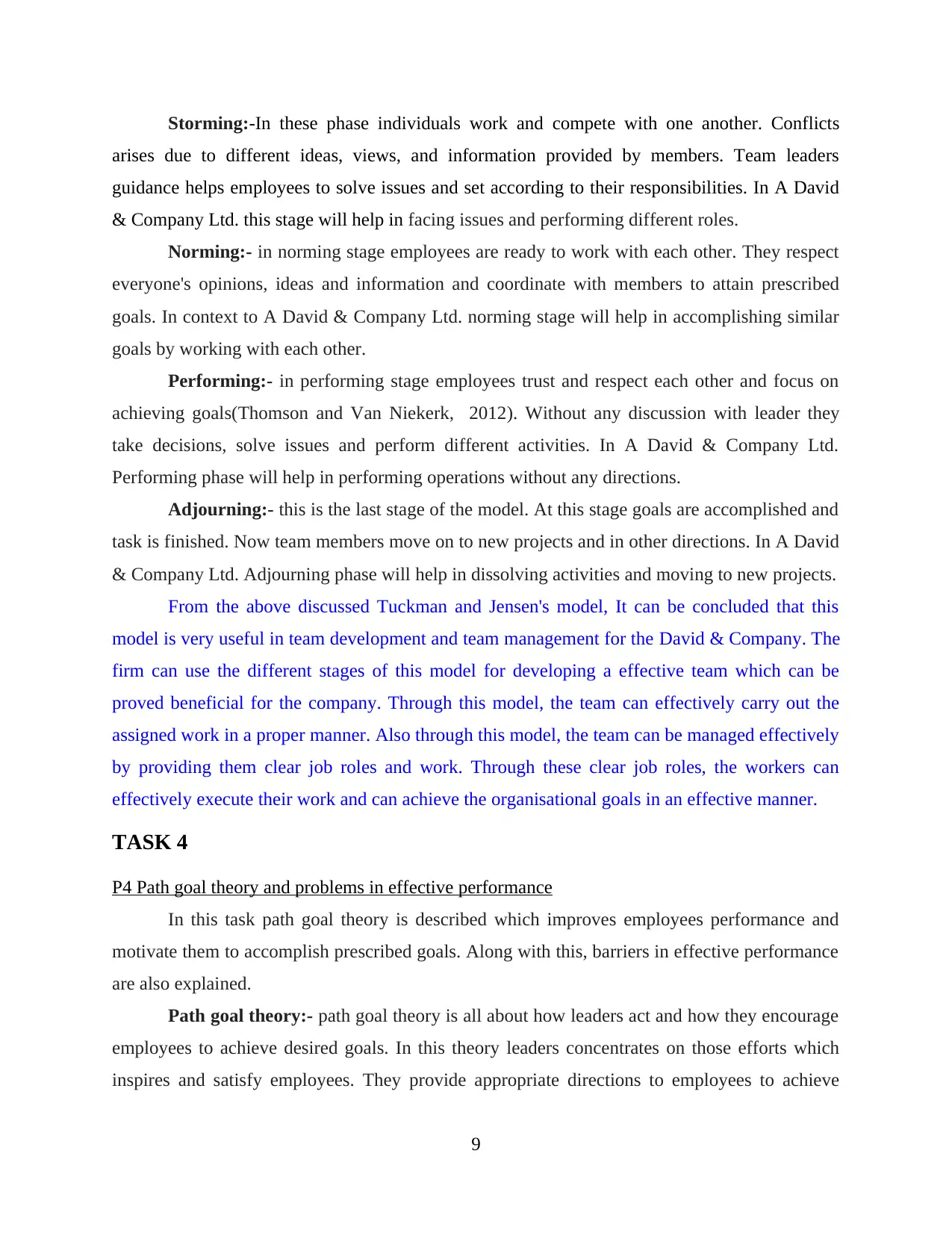
Storming:-In these phase individuals work and compete with one another. Conflicts
arises due to different ideas, views, and information provided by members. Team leaders
guidance helps employees to solve issues and set according to their responsibilities. In A David
& Company Ltd. this stage will help in facing issues and performing different roles.
Norming:- in norming stage employees are ready to work with each other. They respect
everyone's opinions, ideas and information and coordinate with members to attain prescribed
goals. In context to A David & Company Ltd. norming stage will help in accomplishing similar
goals by working with each other.
Performing:- in performing stage employees trust and respect each other and focus on
achieving goals(Thomson and Van Niekerk, 2012). Without any discussion with leader they
take decisions, solve issues and perform different activities. In A David & Company Ltd.
Performing phase will help in performing operations without any directions.
Adjourning:- this is the last stage of the model. At this stage goals are accomplished and
task is finished. Now team members move on to new projects and in other directions. In A David
& Company Ltd. Adjourning phase will help in dissolving activities and moving to new projects.
From the above discussed Tuckman and Jensen's model, It can be concluded that this
model is very useful in team development and team management for the David & Company. The
firm can use the different stages of this model for developing a effective team which can be
proved beneficial for the company. Through this model, the team can effectively carry out the
assigned work in a proper manner. Also through this model, the team can be managed effectively
by providing them clear job roles and work. Through these clear job roles, the workers can
effectively execute their work and can achieve the organisational goals in an effective manner.
TASK 4
P4 Path goal theory and problems in effective performance
In this task path goal theory is described which improves employees performance and
motivate them to accomplish prescribed goals. Along with this, barriers in effective performance
are also explained.
Path goal theory:- path goal theory is all about how leaders act and how they encourage
employees to achieve desired goals. In this theory leaders concentrates on those efforts which
inspires and satisfy employees. They provide appropriate directions to employees to achieve
9
arises due to different ideas, views, and information provided by members. Team leaders
guidance helps employees to solve issues and set according to their responsibilities. In A David
& Company Ltd. this stage will help in facing issues and performing different roles.
Norming:- in norming stage employees are ready to work with each other. They respect
everyone's opinions, ideas and information and coordinate with members to attain prescribed
goals. In context to A David & Company Ltd. norming stage will help in accomplishing similar
goals by working with each other.
Performing:- in performing stage employees trust and respect each other and focus on
achieving goals(Thomson and Van Niekerk, 2012). Without any discussion with leader they
take decisions, solve issues and perform different activities. In A David & Company Ltd.
Performing phase will help in performing operations without any directions.
Adjourning:- this is the last stage of the model. At this stage goals are accomplished and
task is finished. Now team members move on to new projects and in other directions. In A David
& Company Ltd. Adjourning phase will help in dissolving activities and moving to new projects.
From the above discussed Tuckman and Jensen's model, It can be concluded that this
model is very useful in team development and team management for the David & Company. The
firm can use the different stages of this model for developing a effective team which can be
proved beneficial for the company. Through this model, the team can effectively carry out the
assigned work in a proper manner. Also through this model, the team can be managed effectively
by providing them clear job roles and work. Through these clear job roles, the workers can
effectively execute their work and can achieve the organisational goals in an effective manner.
TASK 4
P4 Path goal theory and problems in effective performance
In this task path goal theory is described which improves employees performance and
motivate them to accomplish prescribed goals. Along with this, barriers in effective performance
are also explained.
Path goal theory:- path goal theory is all about how leaders act and how they encourage
employees to achieve desired goals. In this theory leaders concentrates on those efforts which
inspires and satisfy employees. They provide appropriate directions to employees to achieve
9
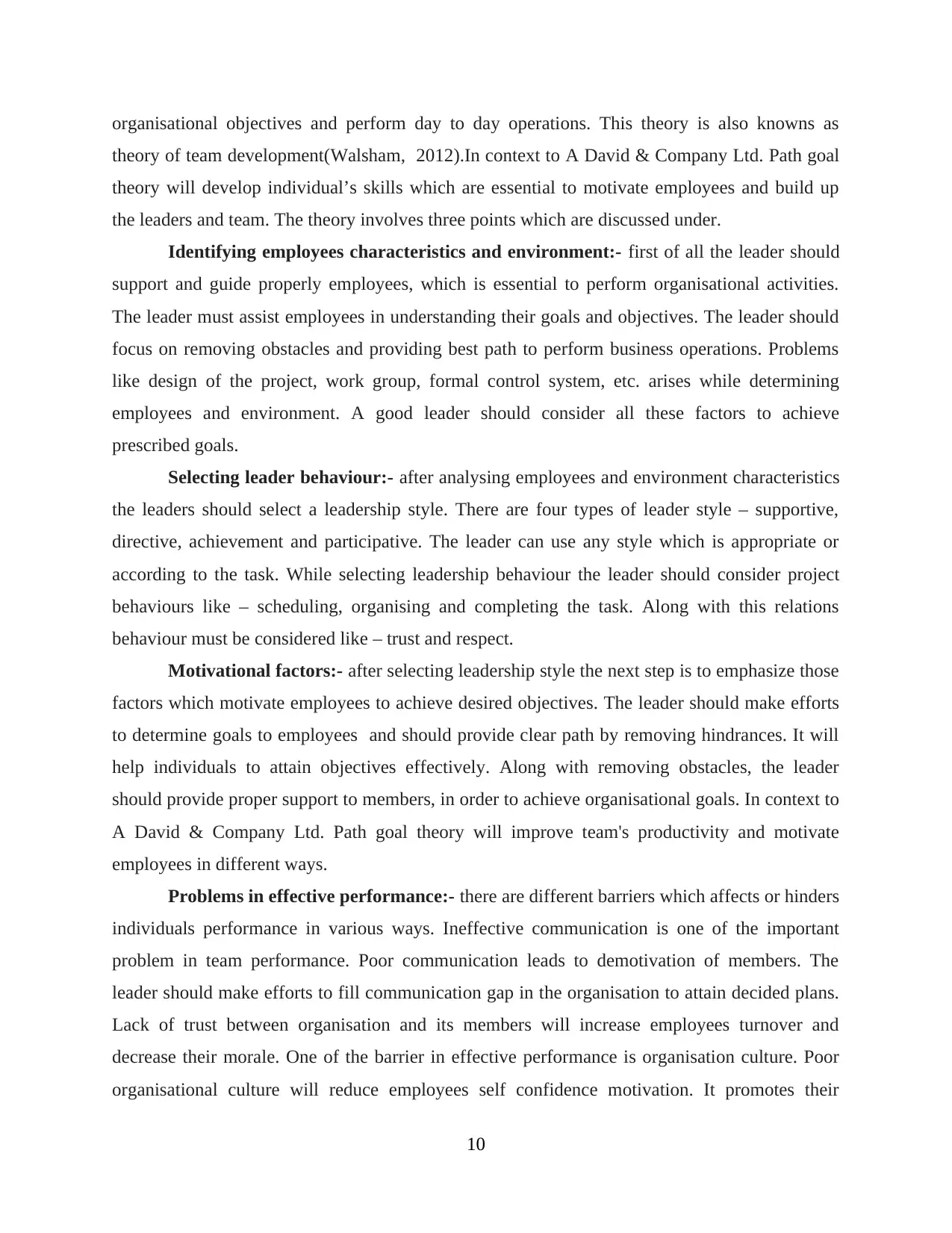
organisational objectives and perform day to day operations. This theory is also knowns as
theory of team development(Walsham, 2012).In context to A David & Company Ltd. Path goal
theory will develop individual’s skills which are essential to motivate employees and build up
the leaders and team. The theory involves three points which are discussed under.
Identifying employees characteristics and environment:- first of all the leader should
support and guide properly employees, which is essential to perform organisational activities.
The leader must assist employees in understanding their goals and objectives. The leader should
focus on removing obstacles and providing best path to perform business operations. Problems
like design of the project, work group, formal control system, etc. arises while determining
employees and environment. A good leader should consider all these factors to achieve
prescribed goals.
Selecting leader behaviour:- after analysing employees and environment characteristics
the leaders should select a leadership style. There are four types of leader style – supportive,
directive, achievement and participative. The leader can use any style which is appropriate or
according to the task. While selecting leadership behaviour the leader should consider project
behaviours like – scheduling, organising and completing the task. Along with this relations
behaviour must be considered like – trust and respect.
Motivational factors:- after selecting leadership style the next step is to emphasize those
factors which motivate employees to achieve desired objectives. The leader should make efforts
to determine goals to employees and should provide clear path by removing hindrances. It will
help individuals to attain objectives effectively. Along with removing obstacles, the leader
should provide proper support to members, in order to achieve organisational goals. In context to
A David & Company Ltd. Path goal theory will improve team's productivity and motivate
employees in different ways.
Problems in effective performance:- there are different barriers which affects or hinders
individuals performance in various ways. Ineffective communication is one of the important
problem in team performance. Poor communication leads to demotivation of members. The
leader should make efforts to fill communication gap in the organisation to attain decided plans.
Lack of trust between organisation and its members will increase employees turnover and
decrease their morale. One of the barrier in effective performance is organisation culture. Poor
organisational culture will reduce employees self confidence motivation. It promotes their
10
theory of team development(Walsham, 2012).In context to A David & Company Ltd. Path goal
theory will develop individual’s skills which are essential to motivate employees and build up
the leaders and team. The theory involves three points which are discussed under.
Identifying employees characteristics and environment:- first of all the leader should
support and guide properly employees, which is essential to perform organisational activities.
The leader must assist employees in understanding their goals and objectives. The leader should
focus on removing obstacles and providing best path to perform business operations. Problems
like design of the project, work group, formal control system, etc. arises while determining
employees and environment. A good leader should consider all these factors to achieve
prescribed goals.
Selecting leader behaviour:- after analysing employees and environment characteristics
the leaders should select a leadership style. There are four types of leader style – supportive,
directive, achievement and participative. The leader can use any style which is appropriate or
according to the task. While selecting leadership behaviour the leader should consider project
behaviours like – scheduling, organising and completing the task. Along with this relations
behaviour must be considered like – trust and respect.
Motivational factors:- after selecting leadership style the next step is to emphasize those
factors which motivate employees to achieve desired objectives. The leader should make efforts
to determine goals to employees and should provide clear path by removing hindrances. It will
help individuals to attain objectives effectively. Along with removing obstacles, the leader
should provide proper support to members, in order to achieve organisational goals. In context to
A David & Company Ltd. Path goal theory will improve team's productivity and motivate
employees in different ways.
Problems in effective performance:- there are different barriers which affects or hinders
individuals performance in various ways. Ineffective communication is one of the important
problem in team performance. Poor communication leads to demotivation of members. The
leader should make efforts to fill communication gap in the organisation to attain decided plans.
Lack of trust between organisation and its members will increase employees turnover and
decrease their morale. One of the barrier in effective performance is organisation culture. Poor
organisational culture will reduce employees self confidence motivation. It promotes their
10
⊘ This is a preview!⊘
Do you want full access?
Subscribe today to unlock all pages.

Trusted by 1+ million students worldwide
1 out of 14
Related Documents
Your All-in-One AI-Powered Toolkit for Academic Success.
+13062052269
info@desklib.com
Available 24*7 on WhatsApp / Email
![[object Object]](/_next/static/media/star-bottom.7253800d.svg)
Unlock your academic potential
Copyright © 2020–2025 A2Z Services. All Rights Reserved. Developed and managed by ZUCOL.





